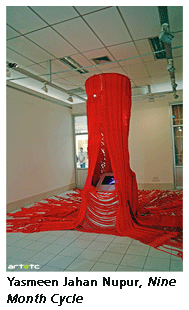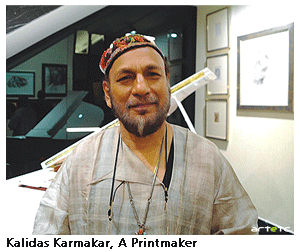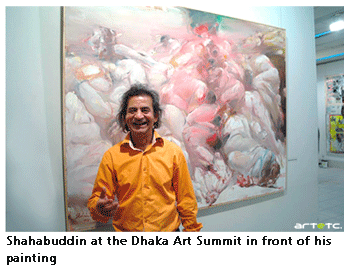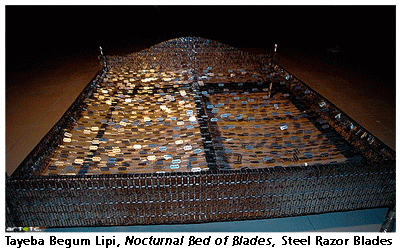- Publisher's Note
- Editorial
- Jogen Chowdhury: Maestro par Excellence
- Company School Paintings of Calcutta, Murshidabad, Patna (1750-1850): Doctoral Thesis of Late Dipak Bhattacharya (1960-2007)
- Kalighat Pat, a Protomodern Art Tradition?
- Academic Naturalism in Art of Bengal: The First Phase of Modernity
- Under the Banyan Tree - The Woodcut Prints of 19th Century Calcutta
- The Arabian Nights and the Web of Stories
- Gaganendranath Tagore's Satirical Drawings and Caricatures
- Gaganendranath's Moments with Cubism: Anxiety of Influence
- Abanindranath as Teacher: Many Moods, Some Recollections
- Atul Bose: A Short Evaluation
- J.P. Gangooly: Landscapes on Canvas
- Defined by Absence: Hemen Majumdar's Women
- Indra Dugar: A Profile of a Painter
- The Discreet Charm of Fluid Lines!
- Delightful Dots and Dazzling Environments: Kusama's Obsessive Neurosis
- Peaceful be Your Return O Lovely Bird, from Warm Lands Back to My Window
- Shunya: A Beginning from a Point of Neutrality
- The Tagore Phenomenon, Revisited
- The Bowl, Flat and Dynamic Architecture of the BMW Museum
- Baccarat Paperweights: Handmade to Perfection
- Byzantium and Islam: Age of Transition at the Metropolitan Museum of Art
- Outstanding Egyptian Art at the Metropolitan Museum of Art
- Retrospective of Wu Guanzhong at the Asia Society Museum
- Masterpieces from India's Late Mughal Period at the Asia Society Museum
- The Dhaka Art Summit: Emergence of Experimental Art Forms
- Many Moods of Eberhard Havekost
- Random Strokes
- Is it Putin or the Whole Russian State?
- The Onus Lies With Young India
- What Happened and What's Forthcoming
- Preview May, 2012 – June, 2012
- In the News, May 2012
- Art Events Kolkata, April – May 2012
- Mumbai Art Sighting
- Delhi Dias
- Art Bengaluru
- Musings from Chennai
- Cover
ART news & views
The Dhaka Art Summit: Emergence of Experimental Art Forms
Issue No: 29 Month: 6 Year: 2012
by Rita Bhimani
Poila Boisakh in Dhaka is a phenomenon of sheer joyful abandon. It was the penultimate day of the Dhaka Art Summit, and the roads looked like so many live installations, replete with colour, surging humanity and actual brushstrokes on the street. At Dhanmondi, where some of the major galleries are housed, we skirted past clusters of people armed with white and red paint, doing massive alpana motifs on the road, almost as if in artistic sync with the summit, if more traditional.
 Elsewhere, at the Bangladesh Shilpakala Academy and at the Bangladesh National Museum, we had witnessed the work of 250 Bangladeshi artists, while the masters could be viewed at the National Museum. The Dhaka Art Summit, masterminded by Nadia and Rajeeb Samdani, is a brand new initiative to give Bangladeshi art an international airing. Which it got in the presence of key personalities at panel discussions which focused on everything from the possibilities of photographic education, the emergence of South Asian Art, to the History of Collecting South Asian Contemporary Artfocusing on Market Connoisseurship and finally a whole session on corporate involvement in art in the presence of the bigwigs of Citibank and Credit Suisse.
Elsewhere, at the Bangladesh Shilpakala Academy and at the Bangladesh National Museum, we had witnessed the work of 250 Bangladeshi artists, while the masters could be viewed at the National Museum. The Dhaka Art Summit, masterminded by Nadia and Rajeeb Samdani, is a brand new initiative to give Bangladeshi art an international airing. Which it got in the presence of key personalities at panel discussions which focused on everything from the possibilities of photographic education, the emergence of South Asian Art, to the History of Collecting South Asian Contemporary Artfocusing on Market Connoisseurship and finally a whole session on corporate involvement in art in the presence of the bigwigs of Citibank and Credit Suisse.
The big names amongst these who gave depth to the summit with their observations were Amin Jaffer, International Director of Asian Art at Christie's, Deepak Ananth, Professor at the Ecole des Beaux Arts, Deepanjana Klein, specialist in the Modern Contemporary South Asian Art Department at Christie's, Fabio Rossi, Director of London's Rossi & Rossi Gallery, Yamini Mehta, Specialist and Head of Modern and Contemporary Indian Art at Christie's, Farooq Sobhan, Chairman of the Advisory Committee of the Dhaka Art Summit.
 Add to this, 19 galleries holding printmaking workshops and group and individual exhibitions, and you had a Dhaka abuzz with “diverse art practices seen across the country” and the “cutting-edge work in a range of mediums including video, sound, installations, digital art, photography and performance art, ” as spelled out by Nadia Samdani.
Add to this, 19 galleries holding printmaking workshops and group and individual exhibitions, and you had a Dhaka abuzz with “diverse art practices seen across the country” and the “cutting-edge work in a range of mediums including video, sound, installations, digital art, photography and performance art, ” as spelled out by Nadia Samdani.
The institution of awards the the announcement of the Samdani Artist Development Award and the Samdani Young Talent award proved to give a leg up to young artists. The One million Bangladesh Taka award went to Khaled Hasan, a thirty something photographer and the BDT 0.5 million award went to Musrat Reazi, a 26 year old assistant teacher in Chittagong. Hers was an oil titled Mooring, done in sepia tones while Khaled's was a powerful set of photographs: Terror Beat on Acid.

Shahabuddin avuncularly led many people through the exhibits, and one cleverly followed in his slipstream to pick out the promising works from amongst a humungous collection of new age art. And at large were artists like Bose Krishnamachari, with his signature metal glasses, with whom we discussed his Kochi Biennale which he has put his heart into and Rashid Rana, one of the most happening artists of his generation in Pakistan.
This being the first year of the Dhaka Art Summit, perhaps the necessary weeding had not taken place, as it was a platform to air the works of as many contemporary Bangladeshi artists as the eye could behold, or the galleries take in. There were many strong voices, installations a plenty and a vast range of mediums used terracotta, beeswax, jute fibre, digital prints, aquatint, and even the use of DVD players, monitors.
 But certain key movements by galleries stood out the Britto Arts Trust being one such, which is an important movement that provides an alternative platform for artists, a non-profit organization that has been supporting experimentation, founded by Tayeba Begum Lipi and her artist husband Mahbubur Rehman. Lipi's work is itself a beacon for the new age artists. No one could miss the searing marital bed installation made by her out of steel razor blades.
But certain key movements by galleries stood out the Britto Arts Trust being one such, which is an important movement that provides an alternative platform for artists, a non-profit organization that has been supporting experimentation, founded by Tayeba Begum Lipi and her artist husband Mahbubur Rehman. Lipi's work is itself a beacon for the new age artists. No one could miss the searing marital bed installation made by her out of steel razor blades.
Drik, another out of the box organization, set up by noted photographer, artist, curator and human rights activist Shahidul Alam, is photography-centric. Included in its ambit is the Bangladesh Photographic Institute, AND Pathshala, the South Asian Media Academy which claims to be amongst the finest schools of photography in the world.
Our last evening was spent at the Dhaka Art Center which has a resource centre with an archive of publications ranging from architecture to theatre and also a selection of films and periodicals; gallery space, studio facilities for print making and for workshops, art camps, seminars, an auditorium and a café which sustains the whole centre.

One must concede that this whole initiativethe Samdani Art Foundation, which came out of a desire to try and establish “Bangladesh's emergence in the global art market” by a dynamic young couple like the Samdanis is likely to catapult the contemporary art scene in Bangladesh into another sphere and “draw global attention to the vibrant art scene” in that country. Plans for the next summit are already on, which could get more inclusive for the South Asian scenario.